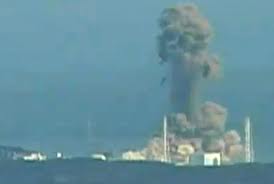
 How do we know how much radiation is reaching Canada from Fukushima? The US uses a system of RadNet monitors. Radiation monitors are "point source" monitors, meaning that the radioactive element or ray must actually strike the monitor to be measured. They are unlikely to detect radiation as close as twenty five feet above or beside them. Apparently there are only about 125 of these monitors for the entire continental United States, Hawaii and Alaska.
How do we know how much radiation is reaching Canada from Fukushima? The US uses a system of RadNet monitors. Radiation monitors are "point source" monitors, meaning that the radioactive element or ray must actually strike the monitor to be measured. They are unlikely to detect radiation as close as twenty five feet above or beside them. Apparently there are only about 125 of these monitors for the entire continental United States, Hawaii and Alaska.Feel secure yet?
News reports mention Iodine-131 and Cesium-137, not because they are the only radioactive elements discharged from the stricken reactors in Fukushima, but because they are the easiest to detect and measure. They both give off gamma rays (like x-rays for which technicians wear little badges) when they decay. Iodine releases gamma rays directly and cesium, indirectly when its short-lived decay product, barium-137m, undergoes further decay.
According to reports from the Gentilly 2 reactor in Quebec, there are 48 radioactive elements identified in regular emissions and, according to the Canadian Nuclear Safety Commission, there may be more than 225 radioactive elements produced in a fully functioning nuclear reactor. Aside from plutonium, news reports are silent.
Alpha and beta radioactivity are more difficult to measure. RadNet measures them by "vacuuming" the air and passing it through a filter. The amount on the filter is then measured. Sources are contradictory about amount of time between detection, measurement and speed at which the public can be informed.
Because of their poor external penetrance – alpha particles can’t penetrate skin and beta particles don’t go much further than a few millimeters – their danger has been discounted. As internal emitters, however, their damage can be extensive. Absorbed in a human body through eating or breathing, they can change enzymes, dislodge ions, and upset strands of DNA.
Radioactive iodine-131 causes cancer by this type of mechanism. The human body absorbs iodine from food for the production of a thyroid hormone that is important for normal growth, intellectual ability and daily energy – ask anyone who has had a "low" thyroid. While in the thyroid, radioactive iodine emits beta particles. Cells have genes which determine their rate of growth and life spans. Beta particles alter these genes and, eventually, in those who develop cancer, turn off the "growth control" gene so that cells grow wildly out of control producing cancer.
Fortunately the danger from radioactive iodine is relatively short-lived. With a half-life of eight days, one tonne becomes a mere 62.5 kilograms in a month. The danger can be decreased but not eliminated by taking potassium iodide tablets immediately before exposure.
Iodine-131, however, is not the only radioactive element released from Fukushima – or from any nuclear power plant. Physicians for Global Survival would like more openness from safety regulators and government about all isotopes, honesty about methods of measurement and regular updates about risks to vulnerable populations.
Physicians for Global Survival is deeply concerned about the long term health of populations exposed due to accidental or planned releases of radioactivity from Fukushima and from domestic power plants.
You can publish this article on your website as long as you provide a link back to this page.

Be the first to comment